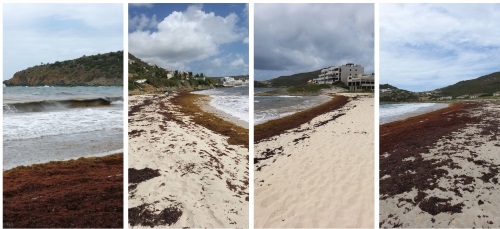 PHILIPSBURG:--- The Nature Foundation is forewarning the public about the increased amounts of Sargassum Seaweed on the Eastern beaches of St. Maarten. As we head into the summer months the temperature increases which causes the sargassum to bloom and large amounts are expected for this summer. This seaweed has been an increasing problem throughout the Caribbean since 2011 landing on beaches in massive amounts and decomposing slowly.
PHILIPSBURG:--- The Nature Foundation is forewarning the public about the increased amounts of Sargassum Seaweed on the Eastern beaches of St. Maarten. As we head into the summer months the temperature increases which causes the sargassum to bloom and large amounts are expected for this summer. This seaweed has been an increasing problem throughout the Caribbean since 2011 landing on beaches in massive amounts and decomposing slowly.
The forecast from the University of South Florida Optical Oceanography Lab predicts that the eastern Caribbean will see large amounts of Sargassum in May to July 2020, as presently the Sargassum amount continued to increase across the central Atlantic. Some of the Lesser Antilles Islands will continue to experience moderate to strong beaching events of sargassum on both their windward and leeward beaches. This situation may continue into summer, and the overall amount is likely to be similar to that in 2015. As large outbreaks of Sargussum occurred in the Caribbean in 2015 and 2018, this month’s predictions show a worrisome summer for Sargassum landings on St. Maarten.
Sargassum is a genus of brown (class Phaeophyceae) seaweed which is distributed throughout the temperate and tropical oceans of the world. Sargassum first plagued St. Maarten in 2011 and 2012, with the Foundation having to warn swimmers to avoid swimming on certain beaches due to a large amount of seaweed and many beach front residences and hotels having to continuously clean washed up Sargassum.
Along with causing a build-up of seaweed on the beaches that visitors and residents both enjoy visiting the decomposing sargassum can cause potential health problems by emitting a colorless, toxic and highly flammable gas called hydrogen sulfide. This gas spreads an unpleasant odor much like the smell of rotten eggs. Residents of areas that are or will be impacted are warned to take precautions to avoid the negative health effects.
“We are advising residents in especially Guana Bay and Point Blanche to keep windows and doors closed as much as possible,” says the Nature Foundation St. Maarten, “When the Sargassum lands and starts to decompose hydrogen sulfide gas is released. Inhaling the gas in small doses can trigger irritation of the eyes and the respiratory system, especially among people who are sensitive to it. The groups most at risk are people with respiratory problems, asthma patients, elderly people, babies and pregnant women. Certain animals, especially dogs, are also sensitive to the inhalation of hydrogen sulfide.”
While there is currently a great deal of research about what can be done with the excess Sargassum Seaweed it should be noted that doing so properly takes time and preparation. Any members of the community wishing to use the seaweed for fertilizer, for example, must diligently research the proper way to prepare the Sargassum to keep themselves, others in the area, and animals nearby safe.









